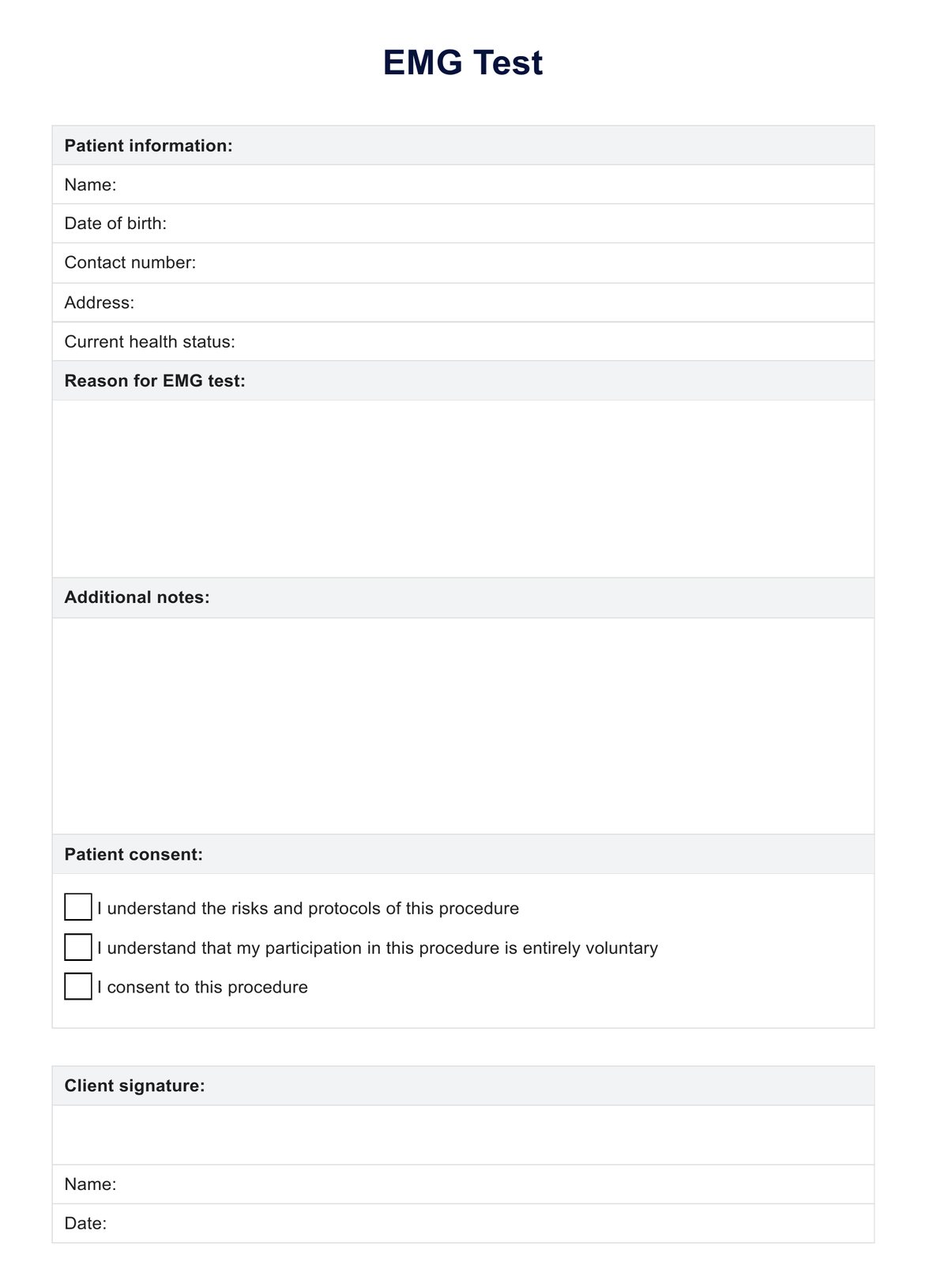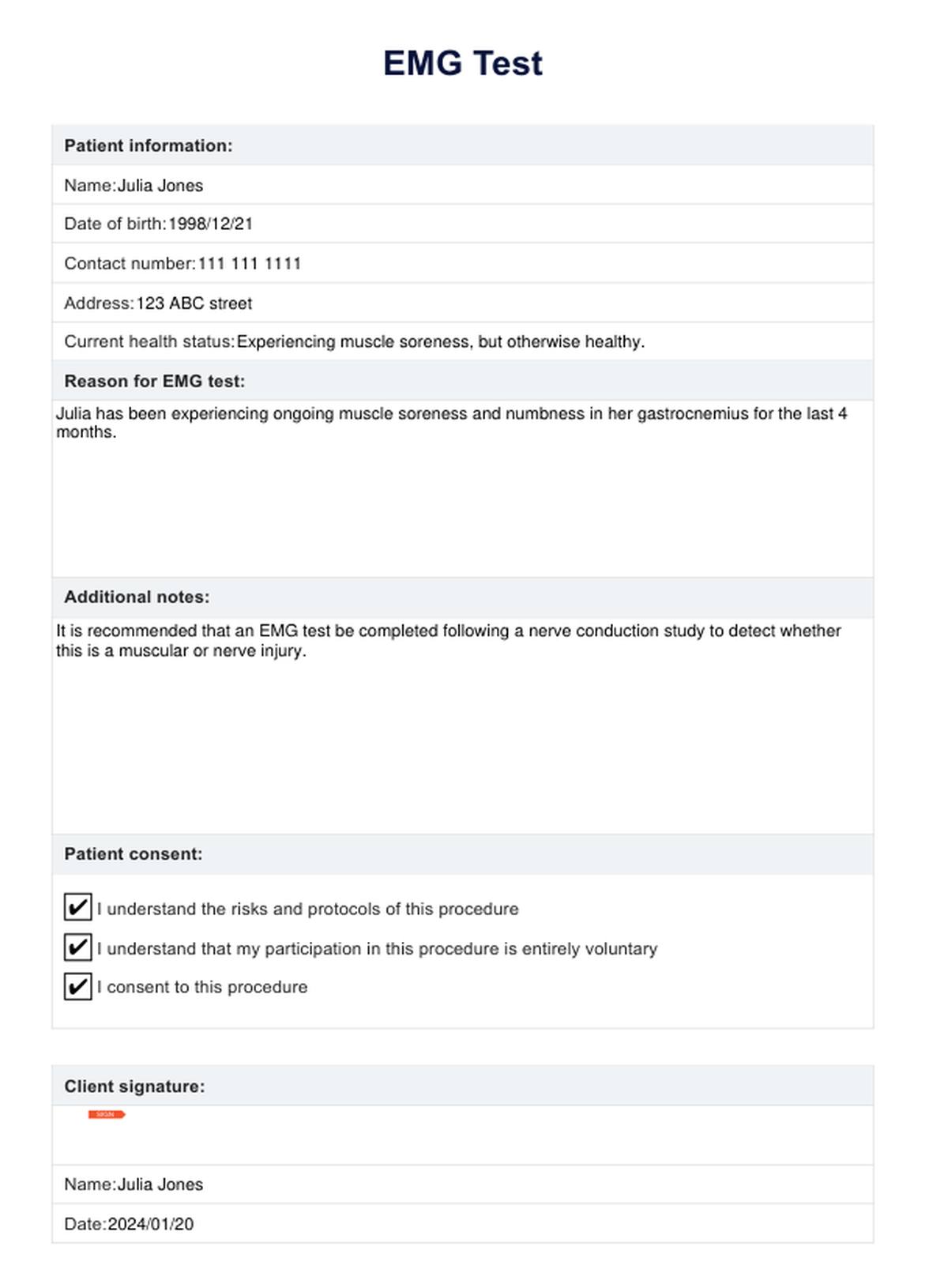Electromyography (EMG)
If you or a client are experiencing muscle pain or numbness, it may be beneficial to complete an EMG test. Read this guide to learn more and receive a free template!


What is Electromyography (EMG)?
An electromyography (EMG) test is a screening procedure that detects electrical signals within the body to assess muscle and nerve health. Most typically performed by health practitioners like neurologists, the test is often used to determine nerve damage or muscle disorders related to electrical activity (Mayo Clinic, 2019).
Electrical signals are sent between the central nervous system (the brain's spinal cord) and nerve endings connected to muscles whenever a muscle contracts or moves. Any time you go to move, electrical impulses are sent from the motor nerves to endings in the muscle, which contract the muscle for movement (Cleveland Clinic, 2023). Neurologists use these signals when performing EMG alongside nerve conduction studies by using EMG technology to sense electrical activity or neuromuscular abnormalities.
The EMG can help practitioners observe whether a muscle is responding accordingly to nerve signals, and when used in conjunction with a nerve conduction study, can determine nerve disorders or nerve damage. It does this by inserting a small needle electrode into the muscle of interest, where the EMG measures electrical activity while the muscle is at rest. Then, the EMG will record a slight contraction to record electrical activity.
Practitioners can access a comprehensive file that structures all vital information regarding electrical stimulation during EMG testing using our EMG test template. Once filled, the template can then be used as a form of clinical documentation that can be used to run further diagnostics for medical conditions like carpal tunnel syndrome or amyotrophic lateral sclerosis. It may also be used in alliance with nerve conduction studies or electrodiagnostic testing.
Electromyography (EMG) Template
Electromyography (EMG) Example
When are EMG tests performed?
An EMG test is most typically formed when a practitioner seeks to investigate the activity of muscles and nerves. Scenarios in which this test may be useful include the following:
Muscle disorder testing
When an individual is experiencing muscle soreness, swelling, or numbness, a practitioner may recommend completing an EMG to test whether there is some sort of muscle injury. In this instance, the practitioner will place an electrode over the area to be tested and investigate the electrical activity.
Nerve conduction studies
When used alongside a nerve conduction study, the EMG can help identify whether an issue or injury is related to a muscle disease or nerve injury. The EMG is usually completed following the nerve conduction study and can demonstrate if the issue is related to nerve conduction or if the muscle is not responding to the electrical activity.
Diagnosing muscular dystrophy
Individuals experiencing muscle weakness or pain may find it beneficial to complete an EMG scan. The test may be used as a diagnostic test for muscular dystrophy, from which a practitioner may then look to devise a treatment plan to help alleviate symptoms.
How does an EMG test work?
An EMG test works to investigate the electrical activity at the level of the muscle, helping practitioners gain insight into the communication between muscles and nerves. The following are some steps breaking down the process of an EMG test:
Step 1: Client consultation
If a client experiences any muscle soreness, numbness, pain, or swelling, you may find it beneficial to recommend an EMG test. Discuss the test and identify whether you require a nerve conduction study before scheduling an appointment and attaining client consent.
Step 2: Client preparation
Begin by asking clients to sit or lie on a flat surface. Prepare the skin over the area of interest by cleaning it with a sanitizing wipe. This will remove any remaining oils, lotions, or dead skin cells that may otherwise interrupt the signal.
Step 3: Electrode placement
Place the needle electrode on the skin over the muscle or muscles of interest.
Step 4: Observation
Using the imaging device, you should be able to observe the electrical activity of the muscles and nerves. Ask the client to rest the muscle before asking them to contract the muscle. You should see a spike in electrical activity as the working muscle contracts. If there are little changes or you notice any abnormalities, these may indicate a nerve or muscular issue.
Step 5: Analysis and documentation
When observing the electrical activity, document any changes or observations that may be linked to the muscles. If it is not related to muscular activity, then it is likely that the issue is a nerve problem.
How do I prepare my patient for an EMG test?
Before beginning an EMG test, a few things require consideration that may help prepare your patient and ensure their safety before, during, and after the test. Although these may differ according to the area of the scan and protocols may slightly differ with the clinic, the following are some recommendations and considerations that may be used as preparation:
- Before the test, it is recommended to bathe or shower to remove any excess oils or lotions from the body. Additionally, avoid applying lotions or creams following your shower until after the test, as these products can interrupt the signal.
- If you are on any medications, such as blood thinners, you must advise your practitioner or test coordinator of these. Some medicines may increase the risk of bleeding following an EMG. Therefore, your practitioner may recommend an alternative procedure that may be better suited for you.
- Depending on where the area to be tested is, it may be recommended to wear loose-fitting clothing. This may not only enhance your comfort but can also help your practitioner gain access to the area.
- If you have any electrical devices, such as a pacemaker or an automated insulin pump, please advise your practitioner.
- It may be advised to avoid consuming caffeinated beverages like coffee or energy drinks and smoking at least two to three hours before the test, as these may interrupt the accuracy of the EMG.
What do results mean?
The results from an EMG test are usually provided within 24 to 48 hours following the EMG screening. They can differ among individuals depending on the reasons for the test and the area being tested. Additionally, while the test can be insightful about electrical activity between muscles and nerves, it is often insufficient to diagnose a condition alone.
Nerve conduction studies investigate the flow of electrical activity from the nerve before activating the muscle fiber. If there is abnormal activity in the nerve conduction study, it may indicate the following:
- Motor neuron disorders in the brain or spine, like amyotrophic lateral sclerosis.
- Nerve disorders like carpal tunnel syndrome that occur outside of peripheral neuropathy (spinal cord nerves).
- Nerve root disorders like herniated disks in the spinal cord.
However, suppose the nerve conduction study results return normal, but the EMG tests see abnormal activity. There is likely some muscle disease or injury, such as muscular dystrophy, in that case.
References
Cleveland Clinic (2023). EMD (Electromyography). Cleveland Clinic. https://my.clevelandclinic.org/health/diagnostics/4825-emg-electromyography
Mayo Clinic (2019). Electromyography (EMG). Mayo Clinic. https://www.mayoclinic.org/tests-procedures/emg/about/pac-20393913
Commonly asked questions
Your healthcare provider usually provides the results from an EMG test within 24 to 48 hours of the test.
Some patients may experience slight pain or discomfort when the needle electrode is inserted, which may differ depending on the investigated area. However, this usually tends to be on the smaller end of the pain scale.
If patients and practitioners follow protocols and preparations for the EMG test appropriately, no severe risks are involved. However, some clients may experience light bleeding following the test, particularly when taking blood thinners.











































































































